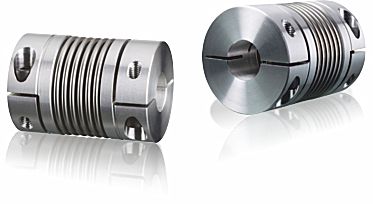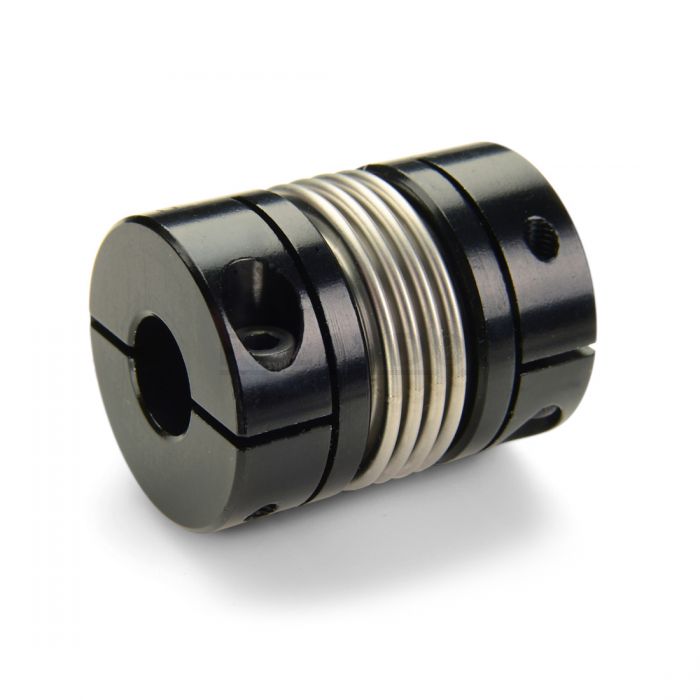Product Description
GRC Aluminum alloy bellows clamping coupling
Description of GRC Aluminum alloy bellows clamping coupling
>The material is aluminum alloy, and the middle bellows is made of stainless steel with excellent corrosion resistance
>Laser welding is used between bellows and shaft sleeve, with zero rotation clearance, suitable for CHINAMFG and reverse rotation
>Bellows structure can effectively compensate radial, angular and axial deviation
>Designed for servo motor stepper motor
>Fastening method of clamping screw
Dimensions of GRC Aluminum alloy bellows clamping coupling
| model parameter | common bore diameter d1,d2 | ΦD | L | L1 | L2 | L3 | N | F | M | tightening screw torque (N.M) |
| GRC-16×27 | 4,5,6,6.35,7,8 | 16 | 27 | 7.5 | 2 | 8 | 13.5 | 3 | M2.5 | 1 |
| GRC-20×32 | 5,6,6.35,7,8,9,9.525,10 | 20 | 32 | 7.2 | 2.8 | 12 | 18 | 3.5 | M3 | 1.5 |
| GRC-22.5×34 | 5,6,6.35,7,8,9,9.525,10,11,12 | 22.5 | 34 | 8.05 | 2.8 | 12.3 | 20.2 | 4.5 | M3 | 1.5 |
| GRC-25×37 | 6,6.35,7,8,9,9,9.525,10,12 | 25 | 37 | 9.5 | 3 | 12 | 20.2 | 4.5 | M3 | 1.5 |
| GRC-32×42 | 8,9,9.525,10,11,12,12.7,14,15 | 32 | 42 | 8 | 4 | 18 | 27.2 | 5.5 | M4 | 2.5 |
| GRC-40×55 | 8,9,9.525,10,11,12,12.7,14,15,16,17,18,19,20 | 40 | 55 | 11.5 | 6 | 20 | 34.5 | 6.5 | M5 | 7 |
| GRC-55×72 | 10,11,12,12.7,14,15,16,17,18,19,20,22,24,25 | 55 | 72 | 16.5 | 6 | 27 | 51.9 | 10 | M6 | 12 |
| GRC-65×81 | 10,11,12,12.7,14,15,16,17,18,19,20,22,24,25,28,30,32,35,38 | 65 | 81 | 19.5 | 7 | 28 | 60.5 | 10.5 | M6 | 12 |
| model parameter | Rated torque (N.M)* |
allowable eccentricity (mm)* |
allowable deflection angle (°)* |
allowable axial deviation (mm)* |
maximum speed rpm |
static torsional stiffness (N.M/rad) |
moment of inertia (Kg.M2) |
Material of shaft sleeve | surface treatment | weight (g) |
| GRC-16×27 | 0.8 | 0.1 | 1.5 | + 0.4 -1.2 | 9400 | 150 | 8.0×10-7 | High strength aluminum alloy | Anodizing treatment | 8 |
| GRC-20×32 | 1.5 | 0.15 | 2 | + 0.6 -1.8 | 7600 | 220 | 2.2×10-6 | 13 | ||
| GRC-22.5×34 | 1.8 | 0.15 | 2 | + 0.6 -1.8 | 6000 | 300 | 6.5×10-6 | 22 | ||
| GRC-25×37 | 2.0 | 0.15 | 2 | + 0.8 -1.8 | 6100 | 330 | 6.9×10-6 | 30 | ||
| GRC-32×42 | 2.5 | 0.2 | 2 | + 0.8 -2.5 | 4700 | 490 | 2.1×10-5 | 53 | ||
| GRC-40×55 | 6.4 | 0.2 | 2 | + 0.8 -2.5 | 4200 | 530 | 2.3×10-5 | 97 | ||
| GRC-55×72 | 12 | 0.2 | 2 | + 0.8 -2.5 | 3900 | 860 | 3.7×10-5 | 200 | ||
| GRC-65×81 | 18 | 0.2 | 2 | + 0.7 -2.5 | 3500 | 900 | 3.6×10-5 | 380 |
/* March 10, 2571 17:59:20 */!function(){function s(e,r){var a,o={};try{e&&e.split(“,”).forEach(function(e,t){e&&(a=e.match(/(.*?):(.*)$/))&&1

How Do Bellows Couplings Contribute to Reducing Vibrations and Ensuring Smooth Operation?
Bellows couplings play a crucial role in reducing vibrations and ensuring smooth operation in mechanical power transmission systems. They achieve this through their unique design and material characteristics, which allow them to absorb and dampen vibrations effectively. Here’s how bellows couplings contribute to minimizing vibrations and promoting smooth operation:
- Flexible Bellows Design: Bellows couplings feature a thin-walled, accordion-like structure known as the bellows. This design provides flexibility in multiple directions, allowing the coupling to compensate for minor misalignments and shaft movements. The bellows’ flexing action absorbs shocks and vibrations, preventing them from propagating through the system and reducing the transmission of vibration to connected equipment.
- Vibration Damping: The flexible bellows act as a vibration damper, absorbing and dissipating vibrational energy generated during the operation. When the system experiences dynamic forces or sudden shocks, the bellows expand and contract to absorb these forces, preventing them from resonating throughout the system. This damping action helps maintain the stability of the machinery and prevents excessive wear and tear on components.
- No Mechanical Contact: Unlike some coupling types that rely on friction or mechanical contact, bellows couplings transmit torque through pure flexure without any metal-to-metal contact. This feature eliminates backlash and torsional wind-up, further reducing vibration and ensuring smoother operation. As a result, bellows couplings are well-suited for applications requiring high precision and minimal vibration-induced errors.
- High Torsional Stiffness: While bellows couplings are designed to be flexible, they still possess high torsional stiffness. This stiffness ensures accurate torque transmission without any loss, contributing to the overall efficiency and smoothness of the system’s operation.
- Resonance Avoidance: Bellows couplings are designed to have specific critical speeds and resonant frequencies that prevent resonance from occurring within the coupling itself. Resonance can lead to severe vibration amplification, which can be detrimental to the equipment and surrounding components. The careful design of bellows couplings helps avoid such resonance issues.
By effectively dampening vibrations, absorbing shocks, and providing torsional stiffness, bellows couplings contribute to smoother operation, reduced mechanical wear, and increased overall system reliability. Their ability to handle misalignments and their high torsional stiffness make them a popular choice in precision motion control systems, robotics, and various industrial applications where smooth and accurate performance is essential.

How do Bellows Couplings Compare to Other Coupling Types, such as Flexible or Rigid Couplings?
Bellows couplings offer distinct advantages and characteristics that set them apart from other coupling types, such as flexible and rigid couplings. Here is a comparison of bellows couplings with other coupling types:
- Flexibility: Bellows couplings are a type of flexible coupling. They provide excellent angular and axial misalignment compensation while maintaining a high level of torsional rigidity. This flexibility helps to reduce stress on connected equipment and allows for smooth operation even in misaligned conditions.
- Compensation for Misalignment: Flexible couplings, including bellows couplings, can accommodate both angular and parallel misalignments. They are designed to allow a certain degree of relative movement between shafts, which helps prevent damage to shafts and connected equipment due to misalignment or vibration.
- Compactness: Bellows couplings are compact and lightweight, making them suitable for applications where space is limited. The absence of additional components, such as elastomeric elements found in other flexible couplings, contributes to their compact design.
- Torsional Stiffness: Compared to some other flexible couplings, bellows couplings offer higher torsional stiffness. This characteristic ensures efficient torque transmission and precise motion control, making them suitable for applications demanding high torsional rigidity.
- Backlash: Bellows couplings typically have minimal backlash due to the absence of mechanical play or components that can introduce free movement. This characteristic allows for precise positioning and control in motion systems.
- Electrical Isolation: Unlike rigid couplings, bellows couplings provide electrical isolation between shafts, making them ideal for applications where electrical continuity must be maintained or avoided between the connected components.
- Resonance Damping: Bellows couplings can help dampen vibrations and reduce resonance in rotating equipment. This characteristic contributes to smoother operation and prolongs the life of connected components.
On the other hand, rigid couplings are suitable for applications requiring precise shaft alignment and no flexibility. They provide a solid and direct connection between shafts, ensuring efficient torque transmission without any loss due to misalignment. However, rigid couplings cannot compensate for misalignment and are more prone to stress concentration in case of shaft misalignment or vibrations.
While flexible couplings, including bellows couplings, offer misalignment compensation and flexibility, they may have slightly lower torsional stiffness compared to rigid couplings. However, their ability to handle misalignments and provide damping characteristics often outweigh this consideration in many motion control applications.
In summary, bellows couplings combine flexibility, torsional stiffness, electrical isolation, and vibration damping features, making them a versatile choice for various precision motion control applications.

What are the Key Design Considerations when using Bellows Couplings for Precision Applications?
When using bellows couplings in precision applications, several key design considerations must be taken into account to ensure optimal performance and accuracy. These considerations include:
- Torsional Stiffness: In precision applications, maintaining torsional stiffness is crucial to minimize angular deflection and maintain accurate positioning. Choose bellows couplings with high torsional stiffness to ensure precise torque transmission.
- Backlash-Free Design: Backlash can introduce positioning errors in precision systems. Select bellows couplings with minimal or zero backlash to maintain accurate motion control.
- Radial Runout: Ensure that the bellows coupling has low radial runout to prevent eccentricity and vibration during rotation, contributing to smoother operation.
- Material Selection: Choose materials with excellent fatigue resistance and high strength to withstand continuous operation and provide long-lasting performance.
- Misalignment Compensation: Evaluate the required misalignment compensation for the specific application. Bellows couplings should be capable of accommodating both angular and axial misalignments without sacrificing precision.
- Compact Size: For applications with limited space, consider compact bellows couplings that provide high torque capacity in a small form factor.
- Temperature and Corrosion Resistance: If the application involves extreme temperatures or harsh environments, opt for bellows couplings made from materials that offer temperature and corrosion resistance.
- Vibration Damping: Bellows couplings with good vibration damping properties help reduce resonance and maintain system stability during high-speed operations.
- Electrical Isolation: In precision applications with sensitive electronics, consider bellows couplings that provide electrical isolation to prevent electrical currents from passing between shafts.
- Customization: Some precision applications may require tailored solutions. Collaborate with coupling manufacturers to explore custom designs that meet specific requirements.
By carefully considering these design aspects, engineers can select the appropriate bellows coupling that aligns with the precision application’s needs, ensuring accurate motion control, reliability, and enhanced performance.


editor by CX 2024-01-09
